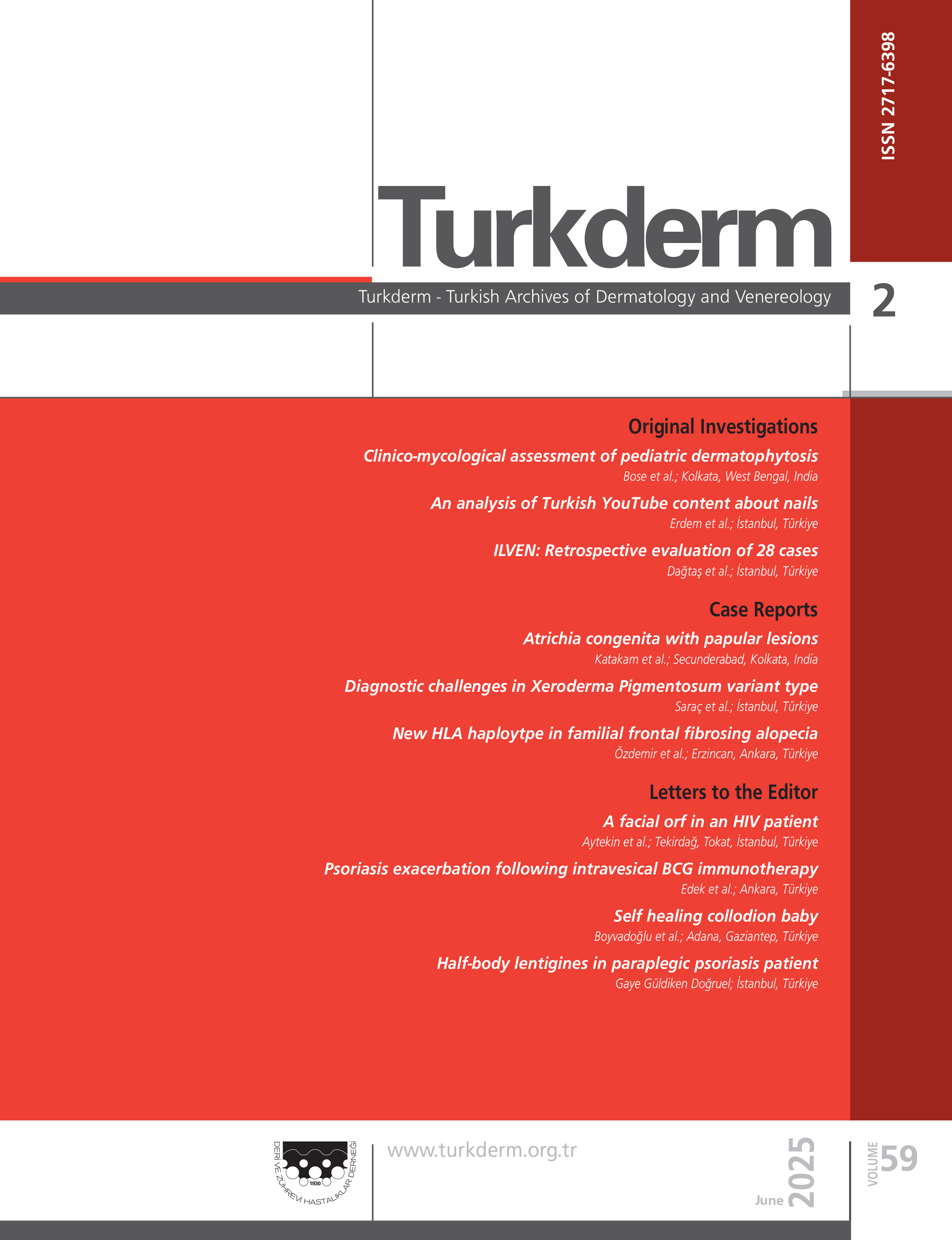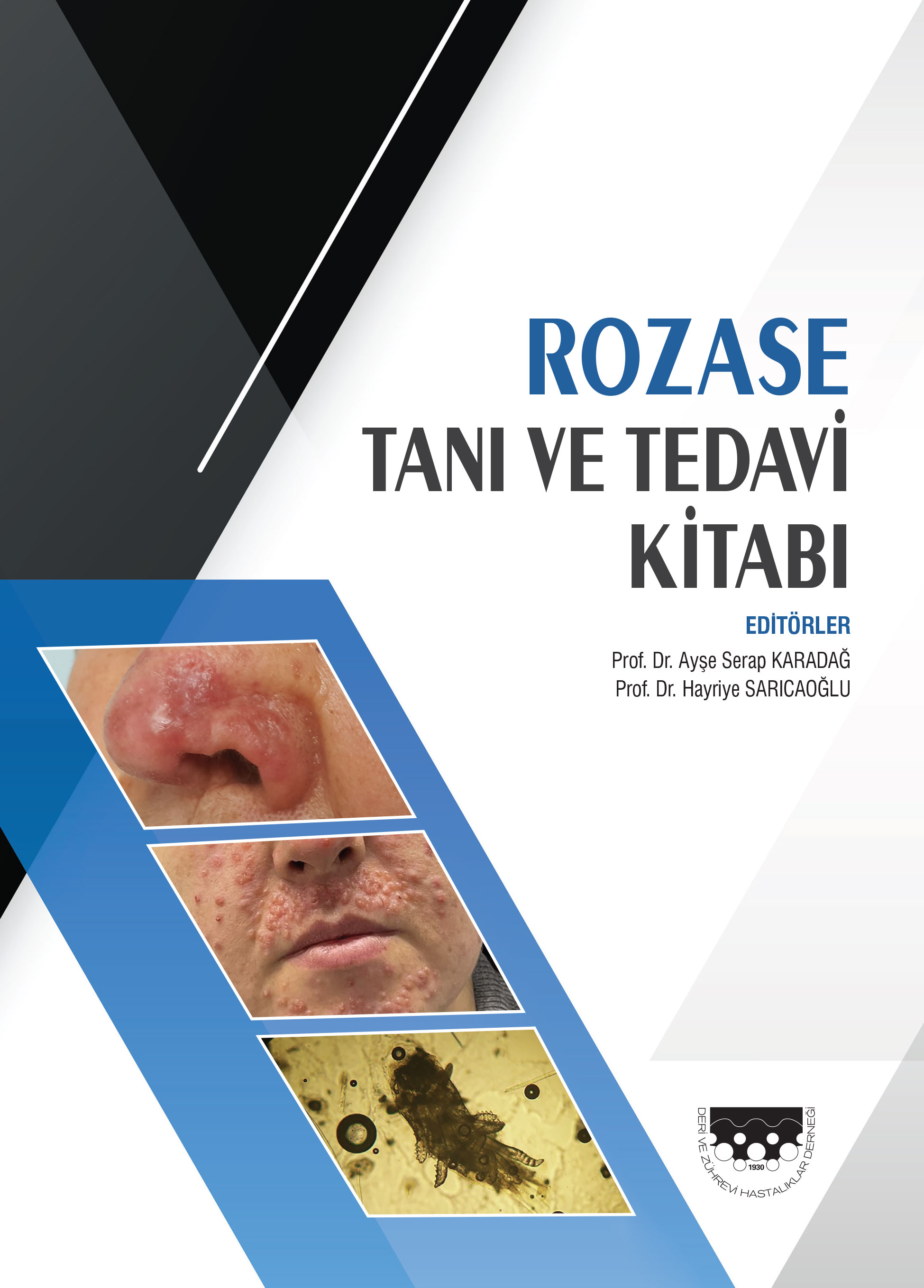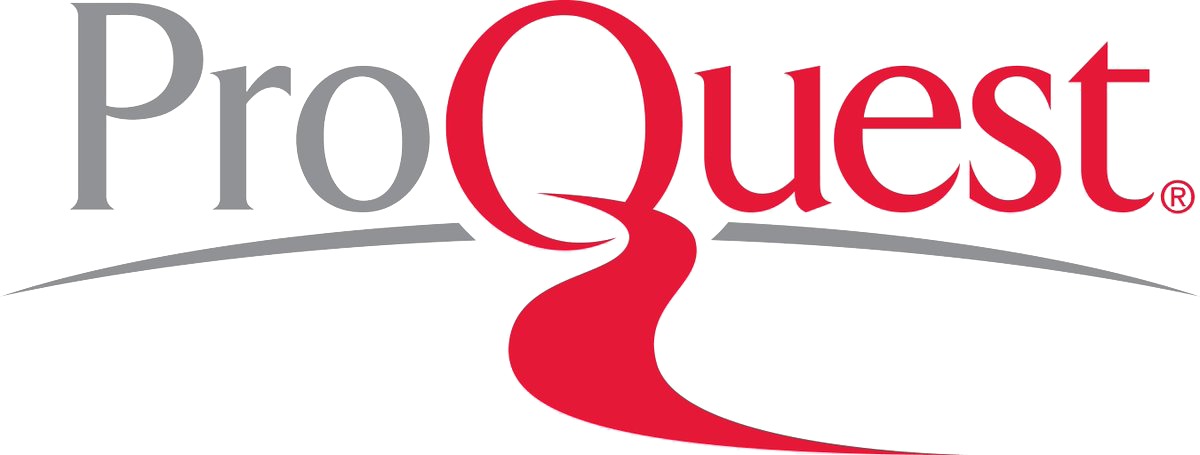Volume: 49 Issue: 1 - 2015
| EDITORIAL | |
| 1. | Editorial Page 1 Abstract | |
| ORIGINAL INVESTIGATION | |
| 2. | A single-blind study comparing acitretin and narrow-band UVB with the combination of placebo and narrow-band UVB in the treatment of plaque-type psoriasis Gülhan Gürel, Zeynep Nurhan Saraçoğlu, Ayşe Esra Koku Aksu doi: 10.4274/turkderm.54771 Pages 2 - 6 Background and Design: In this study, we aimed to compare effects of acitretin and narrow-band UVB with the combination of placebo and narrow-band UVB on the treatment of plaque type psoriasis. Material and Method: A total of 50 patients with plaque type psoriasis in whom more than 10% of body surface area affected were divided into 2 groups of 25 subjects. The first group of patients was treated with narrow-band UVB and 25 mg/day oral acitretin and the second group of patients was treated with narrow-band UVB and placebo. Patients were evaluated every 2 weeks during 12 weeks period. In each patient visit, PASI was evaluated by an independent observer. SAPASI which is assessed by the patient was calculated. Pre- and post-treatment quality of life was evaluated by Skindex 29. Results: The study included a total of 50 patients (25 female, 25 male) aged 18-71 years. When PASI and SAPASI changes were evaluated, there were significant differences between two groups at second week (p<0.05). Also, there were significant differences in terms of PASI and SAPASI values at 4 th, 6 th, 8 th, 10 th and 12 th weeks of two groups (p<0.001). Clinical response was found to be better in patients treated with the combination of acitretin and narrow-band UVB compared to those treated with narrow-band UVB therapy alone. Both treatment protocols were found to lead to significant improvement in the symptoms, function and emotional scales scores of Skindex 29. Conclusion: Because of short and better response of combination treatment clinicians may prefer combination treatment for patients who have psoriasis vulgaris and are suitable for taking narrow-band UVB and acitretin. Psoriasis is considered a kind of disease that has significant impacts on quality of life. |
| 3. | Plasmapheresis/immunoadsorption in patients with pemphigus Rıfkiye Küçükoğlu, Yasemin Erdem, Sevgi Beşışık doi: 10.4274/turkderm.76836 Pages 7 - 12 Background and Design: Plasmapheresis or immunoadsorption which is a more advanced method are among the treatment options that induce a rapid remission in severe and resistant pemphigus. The aim of this study is to evaluate the efficacy and safety of plasmapheresis or immunoadsorption therapies via the clinical experience gained from our patients with pemphigus vulgaris and paraneoplastic pemphigus. Materials and Methods: Among patients who were diagnosed with pemphigus according to the histopathology and/or immunofluorescence methods and followed-up at our bullous diseases outpatient clinic between the years 1987 and 2013, 7 patients (5 PV, 2 PNP), who were treated with plasmapheresis or immunoadsorption, were retrospectively analyzed. Among these patients, 3 were treated with classical plasmapheresis, whereas 2 with double-filtration plasmapheresis, 1 with immunoadsorption, and 1 initially with classical plasmapheresis followed by immunoadsorption due to impairment of the hemodynamic parameters. The clinical findings, antibody titers, and immunological responses before and after the therapy, the therapy dosages and adverse effects were evaluated according to the data gained from the patient files. Results: In 4 patients (1., 3., 4. and 5. patients) with pemphigus vulgaris, complete clinical response was achieved, while 1 patient (2. patient) showed partial regression in skin lesions. In both of the patients (6.,7. patients) with paraneoplastic pemphigus the therapy discontinued due to complications. In all of the evaluated patients, the analysis of the antibody titers before and after the therapy revealed lower levels in comparison to those detected at the initiation of the therapy. In 2 patients hypoalbuminemia and in 2 patients catheter infection were developed as the side effects of the therapy. Conclusion: Even though plasmapheresis or immunoadsorption may be chosen as a good mid-treatment method to decrease the severity of the disease especially in resistant patients with pemphigus, it must be borne in mind that because of the exacerbations that may be seen after the treatment, these therapies should be used in combination with immunosuppressives, and are not effective in the long-term. |
| 4. | The clinical and dermoscopic features of extremity melanomas Fatma Pelin Cengiz, Nazan Emiroğlu, Rainer Hofmann-wellenhof doi: 10.4274/turkderm.69346 Pages 13 - 17 Objectives: Dermoscopy is a noninvasive tool that helps to differentiate structures which can not be seen by naked eye. Dermoscopic and clinical features of malignant melanomas on the extremities are not well described in the literature. Therefore, in this study we aim to determine dermoscopic and clinical characteristics of melanoma on the extremities. Materials and Methods: 40 patients with melanoma on the extremities were included in this study. Their dermoscopic and clinical images, histopathological and clinical data were assessed. The relations between Breslow thickness and dermoscopic characteristics were evaluated. Results: The most frequent localization for women was lower extremities, whereas it was upper extremities for men. The most common subtype of melanoma was superficial spreading melanoma on the extremities. The mean age of patients with extremity melanoma was 56,21 ± 15,20 in men, as well as the mean age of patients with extremity melanoma was 53,09 ± 13,96 in women. The most common dermoscopic feature for extremity melanoma was irregular dots (85%). There were positive correlations between Breslow thickness and diameter, 3 or more colors in lesion, blue-white veil and lineer white streaks, respectively (p< 0.005, r= +0.462) (p< 0.001, r= +0.550) (p< 0.001, r= +0.606) (p< 0.001, r= +0.662). Conclusions: To our knowledge, this is the first study investigating dermoscopic and clinical features in patients with extremity melanomas. We should suggest that melanomas on the lower extremities are more common in women than men and the patients with lower extremity melanomas were younger than the patients with upper extremity melanomas and there are associations between Breslow thickness and some dermoscopic characteristics. |
| 5. | Accompanying conditions in patients with chronic spontaneous urticaria and urticarial vasculitis: Results of a retrospective study Sevgi Akarsu, Turna İlknur, Özlem Özbağçıvan, Emel Fetil doi: 10.4274/turkderm.56323 Pages 18 - 24 Background and Design: Chronic spontaneous urticaria (CSU), the most common form of chronic urticaria, is characterized by spontaneous wheals and/or angioedema lasting longer than six weeks. Urticarial vasculitis (UV) is a small vessel vasculitis; but is also included in the various classification systems of chronic urticaria by some authors. The aim of our study was to evaluate the frequency of accompanying conditions, and to compare the demographic, clinical and laboratory features of patients with CSU and UV. Materials and Methods: In this study, the files of CSU (n=146) and UV (n=43) patients who had been hospitalized between January 2010-December 2013 were retrospectively reviewed in terms of demographic data, disease-specific history, accompanying diseases, medications and laboratory findings. Results: When comparing between the two groups for statistical differences, it was found that the frequencies of personal atopy and angioedema were significantly higher in patients with CSU; however, the patients with UV had significantly higher rates for female gender and the presence of systemic symptoms compared to those with CSU. It was determined that the mean values for erythrocyte sedimentation rate and C-reactive protein, as well as the rates of antinuclear antibody positivity and hypocomplementemia were significantly higher in the UV group, compared with those in the CSU group. Accompanying factors were determined as infections, medications, autoimmune diseases and malignities in order of frequency in both CSU and UV groups, but only the frequency of autoimmune diseases was significantly higher in patients with UV group. Conclusion: Although various authors have reported that a large number (up to 40-60%) of patients with UV may present only with wheals (clinically indistinguishable from CSU); we assumed that it would be more appropriate to be considered UV as a priority in patients especially who had systemic symptom, autoimmune disease, hypocomplementemia and raised serologic inflammatory parameters. |
| 6. | Analysis of serum cytokine levels in patients with pemphigus vulgaris Derya Uçmak, Zeynep Meltem Akkurt, Hatice Yüksel, Mustafa Arıca doi: 10.4274/turkderm.71135 Pages 25 - 30 Background and Design: Pemphigus vulgaris is an autoimmune blistering skin disease. The aim of this study was to compare levels of T helper 1 (Th1), T helper 2 (Th2) and T helper 17 (Th17) type cytokines in pemphigus vulgaris patients and healthy controls. Materials and Methods: The study population included 37 patients with PV and 35 healthy individuals. The patients were grouped into mild, moderate and severe disease groups according to the severity of skin and mucosal involvement. Serum interleukin(IL)-2, IL-4, IL-6, IL-8, IL-10, IL-12, IL-17A and interferon(IFN)-γ levels were assessed using the enzyme-linked immunosorbent assay method. Serum cytokine levels of patients versus controls and between patient subgroups were compared. Analysis of data was done using SPSS 15.0. Results: Serum IL-2, IL-4, IL-6 levels were significantly higher in the patient group compared to the control group (p<0.001, p<0.001, p<0.001, respectively). IL-6 levels were found to be correlated with the severity of disease (r=0.490, p=0.003). Serum cytokine levels of the patient subgroups were not statistically different. Conclusion: Th2 type cytokines were found to be increased in serum of patients with pemphigus vulgaris. These results support that the Th2 cytokine response plays a major role in the etiopathogenesis of pemphigus vulgaris. |
| 7. | The knowledge and attitudes towards complementary and alternative medicine among dermatologists in Turkey Kürşat Göker, Hamza Yıldız, Ercan Karabacak, Bilal Doğan doi: 10.4274/turkderm.88964 Pages 31 - 36 Background and Design: This study aimed to evaluate the knowledge of dermatologists on Complementary and Alternative Medicine (CAM), common methods that are widely used in their daily practices and their general approach about CAM. Materials and Methods: This cross-sectional and descriptive study was carried out between May 2012 and May 2013. A questionnaire comprising 14 questions was sent to dermatologists via electronic mail. The questionnaires which were returned completely and correctly were included in the study. Results: Two hundred questionnaires were taken into consideration. 25.5% of participants were working at universities, while 20% were working at training and research hospitals, 21% were working at public hospitals and the other 33% were working at private hospitals. 80.5% of participants have little, a little and not at all, 16 % moderate and the other 3.5% of them had only a lot, very much level of information about CAT. The most frequently recommended methods among the dermatologist were topical herbal treatment (59.6%), oral herbal treatment (48.1%), herbal shampoo (46.2%), and dietary supplement and thermal spring (38.5%), respectively. Conclusion: Although many of our colleagues have lack of information about CAM, a considerable number of them could use CAM in their daily practices. A substantial proportion of dermatologists would like to be better informed about CAM. |
| 8. | An investigation of poor prognostic factors in patients with alopecia areata and their relatives Hatice Ergün Duman, Afet Akdağ Köse, Halim İşsever doi: 10.4274/turkderm.84666 Pages 37 - 40 Background and Design: Alopecia areata (AA) is characterized by non-scatricial hair loss with exacerbations and remissions. Although its etiopathogenesis is not known, autoimmune factors have been suggested. Our aim was to make contribution to the epidemiological properties of AA in Turkey, and to determine the bad prognostic factors that affect the course of the disease. Materials and Methods: One hundred and thirty-four patients who applied to the Dermatology and Venereology Polyclinic in Istanbul Medical Faculty, Istanbul University were included in the study. The patients were investigated retrospectively in terms of the age, gender, clinical type, involved area of alopecia, severity of the disease, number of relapses, disease duration, age at disease onset, presence of nevus flammeus, nail involvement, history of emotional and/or physical stress, history of AA within the family, and history of atopia within the patients and their relatives. Results: Of the 134 patients, 79 (59 percent) were male, 55 (41 percent) were female and M/F: 1.4/1. The clinical type was AA in 86.5%, alopecia totalis (AT) in 3.7% and alopecia universalis (AU) in 9.7% of the cases. The most common involment was the scalp in both genders and clinically 92.1% was patchy. Severe involvement was found significant in the female patients (p=0.029), in the juvenile onset (p=0.001), in ≥1 year of disease duration (p=0.001), in the presence of nevus flammeus (p=0.017) and in the nail involvement (p=0.015). In the 27.6% of the cases, the family history of AA was present and that was higher in the juvenile group (p=0.034).There was no association between the severity of the disease and atopia. Conclusion: Alopecia areata follows a more severe course in the female patients, juvenile onset patients, patients with nail involvement, patients with nevus flammeus, patients with long disease duration, and patients with the family history of AA than the others. |
| 9. | The effect of psoriasis treatment on body composition, components of metabolic syndrome and psoriatic arthritis Funda Tamer, Mehmet Ali Gürer doi: 10.4274/turkderm.80090 Pages 41 - 44 Background and Design: Psoriasis is a chronic inflammatory immun mediated skin disorder with unknown etiology. The chronic inflammation in psoriasis have role in the development of metabolic and vascular disorders related with associating comorbidities. Recent studies have suggested a strong association exists between metabolic syndrome, obesity and complexity of the association between psoriasis, body mass index (BMI) and psoriasis tratment. In this study, our aim was to investigate the effect of psoriasis treatment with methotrexate, cyclosporine and biological agents on body composition, comorbidities and associated laboratory findings. Materials and Methods: Seventy-nine patients treated with methotrexate, cyclosporin and biological agents were included in our study. Demographic characteristics, body composition analysis, psoriasis related comorbidities and laboratory examinations were evaluated before and after 12 weeks of systemic treatment. Results: Comorbidities and metabolic syndrome tended to be more frequent in the anti tumor necrosis factor alpha (anti-TNF-α) treated group. Increase in body fat and weight detected in patiens receiving biologic drug therapy. Conclusion: The results of our study showed that severe psoriasis patients with longer disease duration were more likely to have metabolic syndrome because of severe and long term inflammation in pathogenesis of comorbidities. |
| 10. | Reliability and validity of internalized stigmatization scale in psoriasis Erkan Alpsoy, Yeşim Şenol, Aslı Bilgiç Temel, G. Özge Baysal, Ayşe Akman Karakaş doi: 10.4274/turkderm.54521 Pages 45 - 49 Backround and design. Internalized stigma involves endorsing negative feelings and beliefs such as insignificance, shame and withdrawal triggered by applying these negative stereotypes to one self. Internalized Stigma Scale has not been applied to psoriasis patients. We aimed to evaluate the reliability and validity of Internalized Stigma Scale in psoriasis patients. Materials and Methods. 100 consecutive, volunteer psoriasis patients (48 female, 52 male; aged, 40.59±15.44 years) were enrolled in the study. PASI and BSA were evaluated by physician (A.B.). Patients responded contemporaneously to Psoriasis Internalized Stigma Scale (PISS), DQoL, and Perceived Health Status (PHS), single-item self-rated general health question, of which Likert scores 1, 2, and 3 were classified as from fair to very poor, and 4, 5 as good. Results. Cronbach's alpha coefficient of PISS subscales was 0.83 for alienation, 0.70 for stereotype endorsement, 0.70 for perceived discrimination, 0.84 for social withdrawal and 0.68 for stigma resistance. The same value was 0.89 for the total scale. PISS and DQoL scores mean values were 58.8±12.6 and 10.0±9.4, respectively. PISS was significantly correlated with the patients' DQoL scores (r=,726, p=0,001). PISS was also significantly correlated with disease duration (r=,209, p=0,047). There was no any significant relationship between PASI or BSA and PISS. Mean DQoL scores in patients reporting their PHS as from fair to very poor and good were 12.1±7.3 and 5.0±4.3, respectively. Mean values of PISS in patients reporting their PHS as from fair to very poor was significantly increased compared with patients reporting their PHS as good (p=0.001). Conclusion. PISS can be used as a reliable and valid tool in assesing internalized stigmatization in psoriasis patients. Our results indicate a high level of stigmatization in psoriasis patients. Low DQoL scores show a correlation with increased levels of internalized stigmatization. PHS is also worse in patients with Low DQoL scores. |
| 11. | Evaluation of 25 hydroxy vitamin D3 levels in patients with alopecia areata Atiye Oğrum, Nermin Boyraz, Arzu Karataş Toğral, Seval Karasatı, Hatice Meral Ekşioğlu doi: 10.4274/turkderm.07888 Pages 50 - 53 Background and Design: Current studies link a possible relationship between vitamin D deficiency and many autoimmune diseases. Alopecia areata(AA) is a frequent autoimmune dermatological disease. The aim of this study was to investigate the relationship between vitamin D levels and alopecia areata; a frequent autoimmune dermatological disease. Materials and Methods: The 25 hydroxyvitamin D (25 OH D) levels of 40 patients with alopecia areata and age, gender and skin phototype matched healthy controls were evaluated. Serum 25 OH D was measured in all subjects, grouped as normal/sufficient (> 30 ng/ml), insufficient (15-30 ng/ml) and deficient (< 15 ng/ml). Results: Both the study and control group were composed of 21 female and 19 males. The mean age were 31.23±7.34 (21-50) and 30.58±7.19 (21-48) respectively. 25 OH D level of study[2.5% (n=1) normal, 15%(n=6) insufficient, 82.5%(n=33)deficient] and control group[2,5%(n=1)normal, 25%(n=10)insufficient, 72,5%(n=29) deficient] were not different(P>0,05). In both groups 97,5% of patients had 25 OH D levels under normal range. Conclusion: Vitamin D levels of patients with AA was similar with the control group This similarity may suggest that a connection between vitamin D and AA does not exist. However, it may also indicate that the relationship between AA and Vitamin D is not via the level but receptor (number and / or structure) of vitamin D. |
| 12. | Comparison of the efficacy and safety of topical clindamycin and 5% benzoyl peroxide with nadifloxacin cream and 5% benzoyl peroxide gel in the treatment of acne vulgaris and assessment of the effects of these treatments on quality of life Aslıhan Kırkağaç, Zeynep Nurhan Saraçoğlu, Ayşe Esra Koku Aksu doi: 10.4274/turkderm.02259 Pages 54 - 59 Background and Design: Acne vulgaris is a multifactorial chronic inflammatory disase of the pilosebaceous unit. Topical antibiotics and anti-inflammatory treatment are used for mild and moderate acne. Clindamycin is frequently used for acne treatment, altough nadifloxacin is a relatively new agent. There are few studies evaluating nadifloxacin efficacy. It's impact on quality of life has not been determined previously. In this study, it is aimed to compare the effect of these two agents, and to evaluate the effect of these treatments on quality of life. Materials and Methods: Eighty patients with mild-moderate acne vulgaris were divided in two groups of 40 people that had no difference in terms of age, gender and acne severity. The combination of topical clindamycin and 5% benzoyl peroxide gel twice a day was given to group 1 for 12 weeks. The combination of nadifloxacin cream and 5% benzoyl peroxide gel twice a day was given to group 2 for 12 weeks. The number of the inflammatory and non-inflammatory lesions were recorded at baseline and on weeks 2, 4, 8, 12 and side effects were recorded and evaluated. Global improvement was evaluated separately by patients and doctor after the treatment. Before and after the treatment, the quality of life of the patients were evaluated with Skindex-29. Results: Both treatment group regimens were significantly effective on inflammatory and non-inflammatory lesions and were well tolerated by patients in terms of side effects. It was also observed that there was statistically significant recovery after treatment in terms of clinical severity and quality of life. There was not any statistically significant difference between two treatment methods in terms of effectiveness, side effect and quality of life. Conclusion: Nadifloxacin and 5% benzoyl peroxide combination is effective in the treatment and improvement of quality of life in acne patients. |
| 13. | Assessment of knowledge, attitudes, and behavior about skin care and moisturizers in patients presenting to dermatology outpatient clinics Munise Daye, İnci Mevlitoğlu, Tahir Kemal Şahin doi: 10.4274/turkderm.82346 Pages 60 - 65 Background and Design: For having a healthy skin; there are cleaning and cosmetic products that are specially prepared (nourishing,moisturizing,sunscreen, etc.) should be used and/or referred to as "skin care". In our study we aimed to determine knowledge and behaviors about skin care and moisturizers of dermatology patients. Materials and Methods: Between March-May 2013, we filled dermatology patients a questionary about their skin care products and moisturizers, behaviours abuot using them, how to use them, where they get knowledge about them, what are the attension points about choosing them, who they are asking for these products, where they buy these products, what are they looking for buying them. Results: The study involved 984 patients.608 (61.8%) were female, 376 (38.2%) were male. In our study; (48.2%) 474 of patient specified that they understand skin care is cleaning, (% 34.2) 337 patient spesified that the lack of skin disease. 303 (30.8%) of patients knew one skin care product, 213% (21.6) of patients knew two skin care products, 284 (28.9%) of patients knew more product, 184% (18.7) of patients didnt know skin care products. 528 (%53,7) patient were using skin products, 200 of them patients were using regularly, 328 were using sometimes. 456 (%46,3) patient were not using skin care products. When they are choosing their skin care products; 648 (%65,9) of them get information from dermatologists, 154 (%15,7) internet, 106 (%10,8) advertisements, 37 (%3,8) their neighbours, 39 (%4) phamacy. 300 (%30,5) patients were using moisturizers, 340 (%34,6) patients were using sometimes, 344 (%35) were not using moisturizers. Conclusion: Our patients did not have the behavior of using skin care products regularly. Our society needs to be informed about regular skin care, and choosing the right moisturizers, buying these products from appropriate places as well as using these products correctly. |
| 14. | Bullous pemphigoid in Erzurum: A 10 year retrospective study Okan Kızılyel, Ömer Faruk Elmas, Handan Bilen, Mahmut Sami Metin, Necmettin Akdeniz, Betül Gündoğdu, Mustafa Atasoy doi: 10.4274/turkderm.12144 Pages 66 - 69 Background and Design: Bullous pemphigoid is a rare autoimmune blistering disease. Aim of the study is to reveal the epidemiology and clinical, laboratory, and radiological features of patients in Erzurum with bullous pemphigoid and to evaluate the association of bullous pemphigoid with comorbid diseases. Methods and Methods: Medical records of 38 patients diagnosed with bullous pemphigoid after biopsy and hospitalized in our clinic between 2003 and 2013 were retrospectively studied. Results: Fifteen (39.5%) of the 38 patients were male, and 23 (60.5%) were female. The mean age at the time of diagnosis was 62.4 ± 21 years. Analyses of the results of direct immunofluorescence showed that the most common findings were the presence of IgG and C3 (42.1%). The average time since the first presentation until diagnosis was 72.7 ± 104.3 days. The mean of the initial dose of corticosteroid was 54.7 ± 26.01 mg/day. The mean of hospitalization for bullous pemphigoid was 22.6 ± 23.5 days. Conclusions: We did not detect any malignancy or comorbid diseases associated with bullous pemphigoid. However, eosinophilia was detected. Routine laboratory and radiological investigations are not necessary to detect malignancy in patients with bullous pemphigoid. |
| CASE REPORT | |
| 15. | The reflectance confocal microscopy features of sebaceous adenoma in a case of Muir Torre syndrome Esma İnan Yüksel, Aslı Turgut Erdemir, Cem Leblebici, Esra Koku Aksu, Mehmet Salih Gürel doi: 10.4274/turkderm.00821 Pages 70 - 74 Muir-Torre syndrome (MTS) is a rare autosomal dominant genodermatosis characterized by the occurrence of sebaceous gland neoplasms and/or keratoacanthomas associated with visceral malignancies. It is considered as a subtype of hereditary nonpolyposis colorectal cancer syndrome. Characteristic sebaceous gland neoplasms include sebaceous adenoma, sebaceous carcinoma, sebaceoma, and keratoacanthoma with sebaceous differentiation. The most common visceral malignancies are colorectal and genitourinary tumors. CASE: A 47year-old male patient admitted to our clinic complaining of two lesions on the nose. Dermatological examination revealed a plaque in 1 cm diameter consisting of bright yellowish-white coloured papules with slightly umblicated appearance and telangiectasias on the left site of the nose and had a dome shaped papule in 3 mm diameter with hyperkeratotic plug on the tip of the nose. He had personal history of partial colon resection because of colon cancer and familial Lynch 2 syndrome. On dermoscopic examination of sebaceous adenoma, a few yellow comedo-like globules and branching arborizing vessels were detected. Reflectance confocal microscopy (RCM) revealed a good histopathologic correlation. Sebaceous lobules were composed by clusters of ovoid cells with hyporefractile dark nuclei and bright, hyperrefractile glistening cytoplasm. Numerous roundish to ovoid dark spaces corresponding to sebaceous ducts were detected. The diagnosis of MTS was established based on the personal and family history, dermoscopic, RCM and histopathologic findings. CONCLUSIONS: MTS evaluation is required in patients with biopsy-proven sebaceous adenoma. Early diagnosis may be lifesaving in patients with MTS. A better characterization of RCM features of sebaceous tumors will allow early diagnosis of the patients with MTS. |
| 16. | Melanotic lupus erythematosus: A rare variant of discoid lupus erythematosus Seval Doğruk Kaçar, Pınar Özuğuz, Betül Demirciler Yavaş, Merve Demir, Hasan İlyas Özardalı doi: 10.4274/turkderm.13471 Pages 75 - 77 Discoid lupus erythematosus (DLE) is characterized by atrophic patches with peripheral hyperpigmentation on sun exposed skin areas. It rarely presents with diffuse hyperpigmented patches without erythema, adherent scale and atrophy on face and neck. This presentation is called as melanotic lupus erythematosus and it is rarely reported in literature. Other diseases that cause facial pigmentation as melasma, Riehl melanosis, lichen planus pigmentosus, drug related pigmentation should be considered in the differential diagnosis. We herein report a 66 year old male patient with diffuse blue-brown pigmentations on his face which was diagnosed as melanotic lupus erythematosus with the clinical, histopathological and immunofluoresence findings. |
| 17. | A case of lenflunomide-induced alopecia areata Gürol Açıkgöz, Yıldıray Yeniay, Ercan Çalışkan, Ercan Arca doi: 10.4274/turkderm.29795 Pages 78 - 80 Leflunomide is an immunomodulatory drug widely used in the treatment of inflammatory arthritis especially in rheumatoid arthritis and psoriatic arthritis. The common side effects of leflunomide are hepatopathy, hypertension, various gastrointestinal complaints and transient hair loss, which were mild and reversible. Although leflunomide is associated with transient hair loss, leflunomide induced alopecia areata was reported previously only in one case. In this case report, we present a 38-year-old male patient who suffered from alopecia areata after leflunomide therapy. |
| 18. | A case of atypical scleromyxedema mimicking angioedema which responded well to acitretin treatment Özlem Ekiz, Bilge Bülbül Şen, Emine Nur Rifaioğlu, Mehmet Yaldız doi: 10.4274/turkderm.78095 Pages 81 - 84 A 37-year-old male patient was admitted our clinic with complaints of edema and mild pruritus on the eyelids, ears, and neck. On dermatological examination there were pale erythema and edema on eyelids and ears; also coarsening of the facial skin and grooving in the forehead lines. In his medical history, it was learned that systemic corticosteroids, antihistamines and epinephrine treatments were given with the diagnosis of urticaria, angioedema for about two months, but he did not benefit from these treatments. A diagnosis of atypical scleromyxedema without monoclonal gammopathy was done according to the clinical, histopathological and laboratory findings. Acitretin treatment with a dose of 35 mg/day was started. Marked regression in the lesions was observed two months later. |
| 19. | A case of systemic lupus erythematosus exacerbated with erythema multiforme-like lesions Şule Yüksel Özcan, Evren Turgay Arısoy, Sema Aytekin, Emre Kaynak, Mehmet Fatih Akdoğan, Pembe Güneş doi: 10.4274/turkderm.81568 Pages 85 - 88 The association of lupus erythematosus (LE) and erythema multiforme (EM) inthe presence of ANA, anti-SS-B/La and RF positivity was described as a new syndrome by Rowell et al in 1962. In 2012, Torchia et al. suggested a novel diagnostic criteria for Rowell syndrome (RS). However, a number of cases which lack thefull spectrum of either set ofdiagnostic criteria, have been reported as RS in the literature. The EM-like lesions seen in these cases have been proposed as a subtype of subacute cutaneous LE. This article presents the case of a 34-year-old female patient with histopathologicallydiagnosed discoid LE, EM-like lesions, and speckled-pattern ANA positivity. Localizations of malar rash, discoid rash and EM-like lesions of patient were not typical in the patient, and there was no triggering factor. Due to the lack of fully novel diagnostic criteria forRS, we concludethat our case is an instance of SLE exacerbated with EM-like lesions. |
| WHAT IS YOUR DIAGNOSIS? | |
| 20. | What is your diagnosis? Ersin Aydın, Ercan Karabacak, Zafer Küçükodacı, Bilal Doğan Pages 89 - 90 Ksantogranuloma en sık rastlanılan Non-Langerhans hücreli histiosiyozdur. Sıklıkla infantil ve çocukluk döneminde gözlenmesi nedeniyle juvenil ksantogranuloma (JKG) olarak adlandırılmıştır. Literatürde çok ender olarak, erişkin yaşta başlangıç gösteren olgulara da rastlanabilmektedir. Burada klinik ve histopatolojik bulgularla erişkin tip ksantogranüloma tanısı konulan 21 yaşında bir erkek hasta sunulmuştur. |
| 21. | ACI KAYBIMIZ Page 91 Abstract | |
| 22. | Asistan Gözüyle 8. Dermatoloji Bahar Sempozyumu Page 92 Abstract | |























